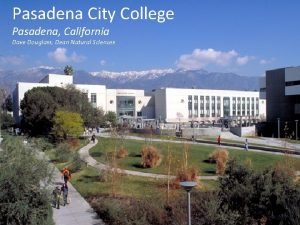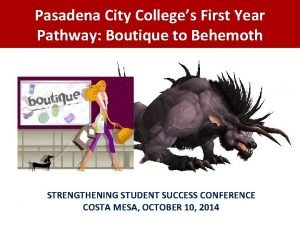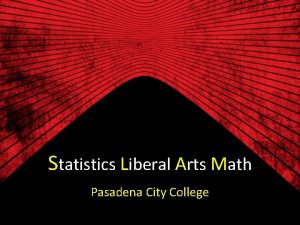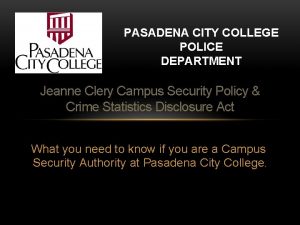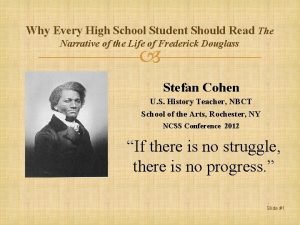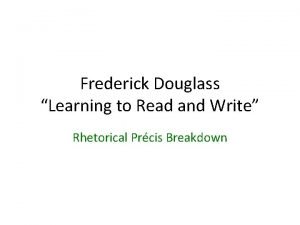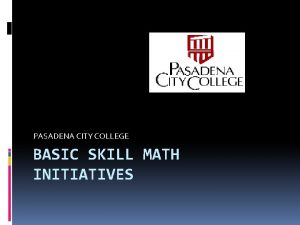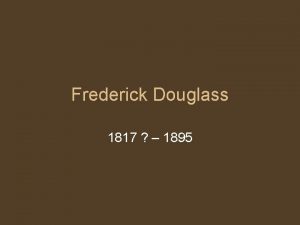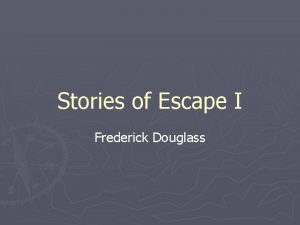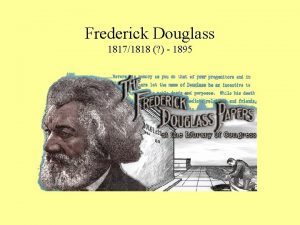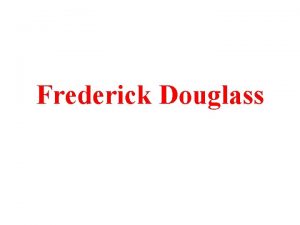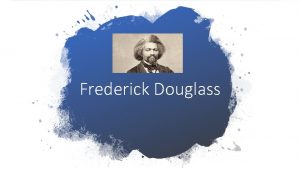Pasadena City College Pasadena California Dave Douglass Dean












- Slides: 12

Pasadena City College Pasadena, California Dave Douglass, Dean Natural Sciences

One of 112 California Community Colleges • ~23, 000 Credit Students • 53 acre urban campus • ~ 1800 students per year transfer to the University of California (UC) of the California State University System (CSU) ETHNICITY 50 45 40 35 30 25 20 15 10 5 0 Hispanic Asian PI White Black Native Amer.

“Traditional” 2 YC Geology Curriculum • Physical -> Historical -> Mineralogy • Emphasis on Field Experiences General Education Courses Oceans, Environmental, Dinosaurs, Hazards, Earth Science etc. Recent Additions… Field Methods Paleontology GIS

Scope of thinking for this session • Programs (whatever that means to you) as opposed to courses… • At our college it means a sequence of courses which leads to something such as… • Transfer, Degree, certificate, or employment • California Completion Agenda

We recognized four key elements to success for students in our STEM Programs • Participation – How do we increasing participation in the geosciences, particularly URM’s • Success - What courses form roadblocks for our students? Understanding the Achievement Gap… • Progression – Where are the exit points? Why do they leave… • Completion – What does this mean for 2 YC’s ?

Think – Pair - Share So mister Sedgwick… Think to yourself for a minute… then turn to your partner to briefly describe you understanding of these 4 elements. Discuss which element (or elements) might be of greatest need within your program and why.

Principles of Good Design A Simplified Backwards Design Process • Start with outcomes (big ideas) and results (sometimes called outputs) • Determine acceptable evidence (what will you measure, how will you know) • Plan strategies and activities to achieve outcomes and results • Assess what resources you have or need

Re so ur ce s s e i g s e t a itie r t S tiv Ac s t l u Res puts Out O s e m utco

Lets Count to 8… Form groups – 2 for each of the following: • Participation • Success • Progression • Completion Each group will need: • A time keeper to keep the group on task • A recorder with access to a lap top…

Opportunity Knocks… The Dean says he might have some money… Using backwards design, work within your group to rough-out a program which might address your groups “element of success” as discussed above… Record your outcomes, desired results, strategies and ideas in the workshop workspace. Capture you resoning the best you can…

Report Outs In… • Twenty Minutes • Fifteen Minutes • Ten Minutes • Five Minutes • Two minutes • NOW!

Thank you! dndouglass@pasadena. edu
 Pasadena city college dean
Pasadena city college dean Pasadena city college pathways
Pasadena city college pathways Pasadena city college statistics
Pasadena city college statistics Pasadena city college police department
Pasadena city college police department Dean d dean
Dean d dean Anna murray-douglass
Anna murray-douglass Tim fredrick
Tim fredrick Katie douglass
Katie douglass Frederick douglass learning to read and write
Frederick douglass learning to read and write Frederick douglass and harriet jacobs
Frederick douglass and harriet jacobs Frederick douglass brainpop
Frederick douglass brainpop Cow toungue
Cow toungue Frederick douglass talbot county
Frederick douglass talbot county
